Blogs
Managing Blisters on the Feet
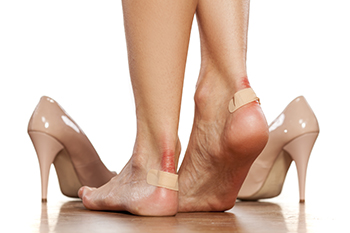
Blisters are small fluid-filled pockets that commonly form on the skin and can be particularly bothersome when they develop on the feet. Whether caused by friction from wearing ill-fitting shoes, prolonged walking, running, or heat, blisters can cause discomfort and interfere with daily activities. While most blisters on the feet heal naturally within a week, it is essential to avoid popping them yourself, as this can increase the risk of infection and prolong recovery time. Instead, gently cover the blister with a dry, sterile dressing to help protect it as it heals. If there are signs of infection, such as redness, swelling, or pus, seeking prompt medical attention from a podiatrist is suggested. Podiatrists may prescribe antibiotics for infected blisters or perform procedures like blister drainage under sterile conditions for larger or more painful blisters. If you experience persistent or recurrent blisters on your feet, it is suggested that you schedule an appointment with a podiatrist to ensure safe and effective treatment as well as prevention strategies.
Blisters may appear as a single bubble or in a cluster. They can cause a lot of pain and may be filled with pus, blood, or watery serum. If your feet are hurting, contact Dr. Dean D. Hinners of Illinois. Our doctor can provide the care you need to keep you pain-free and on your feet.
Foot Blisters
Foot blisters are often the result of friction. This happens due to the constant rubbing from shoes, which can lead to pain.
What Are Foot Blisters?
A foot blister is a small fluid-filled pocket that forms on the upper-most layer of the skin. Blisters are filled with clear fluid and can lead to blood drainage or pus if the area becomes infected.
Symptoms
(Blister symptoms may vary depending on what is causing them)
- Bubble of skin filled with fluid
- Redness
- Moderate to severe pain
- Itching
Prevention & Treatment
In order to prevent blisters, you should be sure to wear comfortable shoes with socks that cushion your feet and absorb sweat. Breaking a blister open may increase your chances of developing an infection. However, if your blister breaks, you should wash the area with soap and water immediately and then apply a bandage to the affected area. If your blisters cause severe pain it is important that you call your podiatrist right away.
If you have any questions, please feel free to contact one of our offices located in Metropolis and Eldorado, IL . We offer the newest diagnostic and treatment technologies for all your foot care needs.
The Importance of Foot Check-Ups For Older Adults
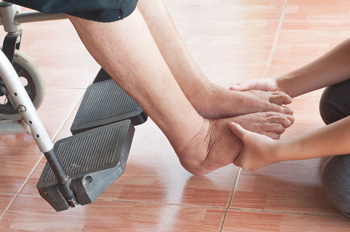 Regular foot assessments and timely management of foot-related issues in older adults play a huge role in maintaining mobility and reducing the risk of falls, which are major concerns for this age group. The feet can change in structure and function as people age. Especially when paired with conditions such as arthritis, diabetes, and circulatory problems, this can significantly impact a person’s ability to walk and perform daily activities safely. By addressing these issues early through routine podiatry care, potential problems can be managed or corrected before they lead to more serious complications and falls. This approach helps older adults both retain their motor performance and independence, as well as reduce their fear of falling. Fear itself can lead to a decrease in physical activity, further diminishing muscle strength and balance, which increases the risk of falls. It is suggested that elderly people with possible foot and aging concerns make regular appointments with a podiatrist, to address any potential problems quickly.
Regular foot assessments and timely management of foot-related issues in older adults play a huge role in maintaining mobility and reducing the risk of falls, which are major concerns for this age group. The feet can change in structure and function as people age. Especially when paired with conditions such as arthritis, diabetes, and circulatory problems, this can significantly impact a person’s ability to walk and perform daily activities safely. By addressing these issues early through routine podiatry care, potential problems can be managed or corrected before they lead to more serious complications and falls. This approach helps older adults both retain their motor performance and independence, as well as reduce their fear of falling. Fear itself can lead to a decrease in physical activity, further diminishing muscle strength and balance, which increases the risk of falls. It is suggested that elderly people with possible foot and aging concerns make regular appointments with a podiatrist, to address any potential problems quickly.
Proper foot care is something many older adults forget to consider. If you have any concerns about your feet and ankles, contact Dr. Dean D. Hinners from Illinois. Our doctor can provide the care you need to keep you pain-free and on your feet.
The Elderly and Their Feet
As we age we start to notice many changes in our body, but the elder population may not notice them right away. Medical conditions may prevent the elderly to take notice of their foot health right away. Poor vision is a lead contributor to not taking action for the elderly.
Common Conditions
- Neuropathy – can reduce feeling in the feet and can hide many life-threatening medical conditions.
- Reduced flexibility – prevents the ability of proper toenail trimming, and foot cleaning. If left untreated, it may lead to further medical issues.
- Foot sores – amongst the older population can be serious before they are discovered. Some of the problematic conditions they may face are:
- Gouging toenails affecting nearby toe
- Shoes that don’t fit properly
- Pressure sores
- Loss of circulation in legs & feet
- Edema & swelling of feet and ankles
Susceptible Infections
Diabetes and poor circulation can cause general loss of sensitivity over the years, turning a simple cut into a serious issue.
If you have any questions please feel free to contact one of our offices located in Metropolis and Eldorado, IL . We offer the newest diagnostic and treatment technologies for all your foot and ankle needs.
Causes and Treatment for Ingrown Toenails
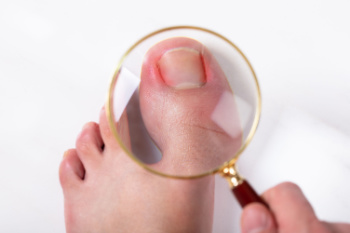
Ingrown toenails can turn simple movements into a painful experience and even lead to infections if left untreated. Ingrown toenails develop when a toenail grows into the surrounding skin, particularly prevalent in the big toe. Factors like wearing ill-fitting footwear, genetics, improper nail trimming, or trauma are common causes of ingrown toenails. Symptoms can include pain, swelling, and redness around the affected nail. Prevention involves wearing properly fitted shoes with roomy toe boxes, trimming nails straight across, and avoiding tight socks. For help in managing severe, infected, or recurring ingrown toenails, treatment from a podiatrist is suggested. This foot doctor can prescribe antibiotics for infections or surgical removal of the toenail, if necessary. A podiatrist can also recommend methods to avoid ingrown toenails in the future. It is suggested that you schedule an appointment with a podiatrist at the first sign of an ingrown toenail.
Ingrown toenails may initially present themselves as a minor discomfort, but they may progress into an infection in the skin without proper treatment. For more information about ingrown toenails, contact Dr. Dean D. Hinners of Illinois. Our doctor can provide the care you need to keep you pain-free and on your feet.
Ingrown Toenails
Ingrown toenails are caused when the corner or side of a toenail grows into the soft flesh surrounding it. They often result in redness, swelling, pain, and in some cases, infection. This condition typically affects the big toe and may recur if it is not treated properly.
Causes
- Improper toenail trimming
- Genetics
- Improper shoe fitting
- Injury from pedicures or nail picking
- Abnormal gait
- Poor hygiene
You are more likely to develop an ingrown toenail if you are obese, have diabetes, arthritis, or have any fungal infection in your nails. Additionally, people who have foot or toe deformities are at a higher risk of developing an ingrown toenail.
Symptoms
Some symptoms of ingrown toenails are redness, swelling, and pain. In rare cases, there may be a yellowish drainage coming from the nail.
Treatment
Ignoring an ingrown toenail can have serious complications. Infections of the nail border can progress to a deeper soft-tissue infection, which can then turn into a bone infection. You should always speak with your podiatrist if you suspect you have an ingrown toenail, especially if you have diabetes or poor circulation.
If you have any questions, please feel free to contact one of our offices located in Metropolis and Eldorado, IL . We offer the newest diagnostic and treatment technologies for all your foot care needs.
Bunion Treatment
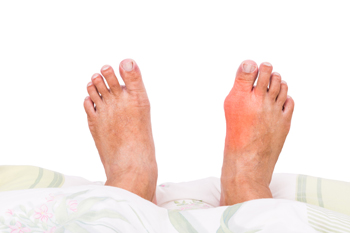
Bunions manifest primarily as the big toe angling towards the other toes, causing a bony protrusion on the inner edge of the foot. Symptoms include pain, swelling, callused skin, and foot shape changes. Treatment aims to alleviate discomfort and may involve painkillers, orthotics, or surgery for severe cases. Untreated bunions can worsen and lead to complications like arthritis or toe misalignment. Bunions are more prevalent in women, possibly due to footwear choices like high heels. Other causes of bunions include genetics, arthritis, and ill-fitting shoes. Prevention involves wearing properly fitting shoes with ample toe room, and avoiding tight or high-heeled footwear. Surgery is often the only solution for severe cases but may not guarantee complete recovery. If you have a bunion that causes you pain, it is suggested that you make appointments with a podiatrist for regular monitoring and treatment.
If you are suffering from bunion pain, contact Dr. Dean D. Hinners of Illinois. Our doctor can provide the care you need to keep you pain-free and on your feet.
What Is a Bunion?
Bunions are painful bony bumps that usually develop on the inside of the foot at the joint of the big toe. As the deformity increases over time, it may become painful to walk and wear shoes. Women are more likely to exacerbate existing bunions since they often wear tight, narrow shoes that shift their toes together. Bunion pain can be relieved by wearing wider shoes with enough room for the toes.
Causes
- Genetics – some people inherit feet that are more prone to bunion development
- Inflammatory Conditions - rheumatoid arthritis and polio may cause bunion development
Symptoms
- Redness and inflammation
- Pain and tenderness
- Callus or corns on the bump
- Restricted motion in the big toe
In order to diagnose your bunion, your podiatrist may ask about your medical history, symptoms, and general health. Your doctor might also order an x-ray to take a closer look at your feet. Nonsurgical treatment options include orthotics, padding, icing, changes in footwear, and medication. If nonsurgical treatments don’t alleviate your bunion pain, surgery may be necessary.
If you have any questions, please feel free to contact one of our offices located in Metropolis and Eldorado, IL . We offer the newest diagnostic and treatment technologies for all your foot care needs.
Wounds That Don't Heal Need to Be Checked
Benefits of Custom Orthotics for Older Adults
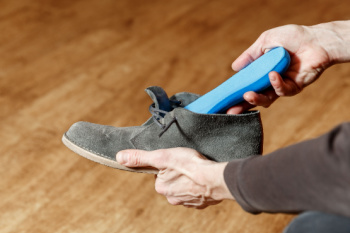
Many older adults have foot and ankle problems that affect their daily activities, balance, and quality of life. These issues, like dry skin, reduced joint movement, and weak feet, often lead to foot deformities, pain, and difficulty walking. Ankle-foot orthoses, or AFOs, are commonly used to help with these problems by supporting joints and improving stability. Custom-made orthotics align the foot, reduce pain, and encourage more physical activity. They can help improve balance and possibly reduce the fear of falling as well. If you are an older adult and are experiencing foot problems, or have a desire to prevent age-related foot conditions from interfering with life, it is suggested that you schedule an appointment with a podiatrist to discuss if custom-made orthotics are the right choice for you. Custom-made orthotics can lead to better balance and more activity, especially for those who wear them consistently.
If you are having discomfort in your feet and would like to try orthotics, contact Dr. Dean D. Hinners from Illinois. Our doctor can provide the care you need to keep you pain-free and on your feet.
What Are Orthotics?
Orthotics are inserts you can place into your shoes to help with a variety of foot problems such as flat feet or foot pain. Orthotics provide relief and comfort for minor foot and heel pain but can’t correct serious biomechanical problems in your feet.
Over-the-Counter Inserts
Orthotics come in a wide variety of over-the-counter inserts that are used to treat foot pain, heel pain, and minor problems. For example, arch supports can be inserted into your shoes to help correct overarched or flat feet, while gel insoles are often used because they provide comfort and relief from foot and heel pain by alleviating pressure.
Prescription Orthotics
If over-the-counter inserts don’t work for you or if you have a more severe foot concern, it is possible to have your podiatrist prescribe custom orthotics. These high-quality inserts are designed to treat problems such as abnormal motion, plantar fasciitis, and severe forms of heel pain. They can even be used to help patients suffering from diabetes by treating foot ulcers and painful calluses and are usually molded to your feet individually, which allows them to provide full support and comfort.
If you are experiencing minor to severe foot or heel pain, it’s recommended to speak with your podiatrist about the possibilities of using orthotics. A podiatrist can determine which type of orthotic is right for you and allow you to take the first steps towards being pain-free.
If you have any questions please contact one of our offices located in Metropolis and Eldorado, IL . We offer the newest diagnostic and treatment technologies for all your foot and ankle needs.
Factors Leading to Foot Pain in Children
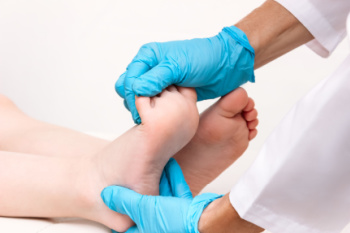 Children, especially young athletes, may experience foot pain for a variety of reasons. Biomechanical issues, like flat feet or high arches, may lead to improper weight distribution and cause foot pain in kids. Wearing ill-fitting footwear, especially shoes that are too tight or lack proper support, can also contribute to foot pain. Children active in sports and physical activities may experience overuse injuries or strains, and can experience foot injuries that are less common in adults because they are still growing. Structural abnormalities, such as toe deformities or differences in leg length, can also play a role in pediatric foot pain. Additionally, conditions including plantar warts, ingrown toenails, or infections can cause discomfort on specific areas of the foot. If your child is experiencing foot pain or a foot injury, it is suggested that you schedule an appointment with a podiatrist for diagnosis and treatment.
Children, especially young athletes, may experience foot pain for a variety of reasons. Biomechanical issues, like flat feet or high arches, may lead to improper weight distribution and cause foot pain in kids. Wearing ill-fitting footwear, especially shoes that are too tight or lack proper support, can also contribute to foot pain. Children active in sports and physical activities may experience overuse injuries or strains, and can experience foot injuries that are less common in adults because they are still growing. Structural abnormalities, such as toe deformities or differences in leg length, can also play a role in pediatric foot pain. Additionally, conditions including plantar warts, ingrown toenails, or infections can cause discomfort on specific areas of the foot. If your child is experiencing foot pain or a foot injury, it is suggested that you schedule an appointment with a podiatrist for diagnosis and treatment.
Foot Pain
Foot pain can be extremely painful and debilitating. If you have a foot pain, consult with Dr. Dean D. Hinners from Illinois. Our doctor will assess your condition and provide you with quality foot and ankle treatment.
Causes
Foot pain is a very broad condition that could be caused by one or more ailments. The most common include:
- Bunions
- Hammertoes
- Plantar Fasciitis
- Bone Spurs
- Corns
- Tarsal Tunnel Syndrome
- Ingrown Toenails
- Arthritis (such as Gout, Rheumatoid, and Osteoarthritis)
- Flat Feet
- Injury (from stress fractures, broken toe, foot, ankle, Achilles tendon ruptures, and sprains)
- And more
Diagnosis
To figure out the cause of foot pain, podiatrists utilize several different methods. This can range from simple visual inspections and sensation tests to X-rays and MRI scans. Prior medical history, family medical history, and any recent physical traumatic events will all be taken into consideration for a proper diagnosis.
Treatment
Treatment depends upon the cause of the foot pain. Whether it is resting, staying off the foot, or having surgery; podiatrists have a number of treatment options available for foot pain.
If you have any questions, please feel free to contact one of our offices located in Metropolis and Eldorado, IL . We offer the newest diagnostic and treatment technologies for all your foot care needs.
Insights Into Definition and Causes of Sever’s Disease
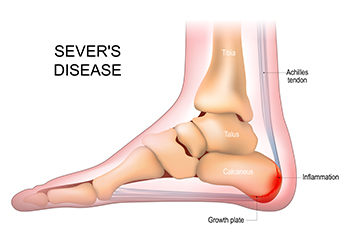
Sever's disease, also known as calcaneal apophysitis, is a common heel condition that primarily affects children and adolescents during periods of rapid growth. Contrary to its name, Sever's disease is not an actual disease but rather an overuse injury that occurs when the growth plate at the back of the heel becomes inflamed. This growth plate, the calcaneal apophysis, is particularly vulnerable during growth spurts when bones, muscles, and tendons develop at different rates. The repetitive stress on the growth plate from activities such as running or jumping can lead to pain, swelling, and tenderness at the back of the heel. Factors such as tight calf muscles, improper footwear, and engaging in high-impact sports contribute to the development of Sever's disease. If your child participates in sporting events and has developed heel pain, it is strongly suggested that you confer with a podiatrist who can accurately diagnose and treat Sever’s disease.
Sever's disease often occurs in children and teens. If your child is experiencing foot or ankle pain, see Dr. Dean D. Hinners from Illinois. Our doctor can treat your child’s foot and ankle needs.
Sever’s Disease
Sever’s disease is also known as calcaneal apophysitis, which is a medical condition that causes heel pain I none or both feet. The disease is known to affect children between the ages of 8 and 14.
Sever’s disease occurs when part of the child’s heel known as the growth plate (calcaneal epiphysis) is attached to the Achilles tendon. This area can suffer injury when the muscles and tendons of the growing foot do not keep pace with bone growth. Therefore, the constant pain which one experiences at the back of the heel will make the child unable to put any weight on the heel. The child is then forced to walk on their toes.
Symptoms
Acute pain – Pain associated with Sever’s disease is usually felt in the heel when the child engages in physical activity such as walking, jumping and or running.
Highly active – Children who are very active are among the most susceptible in experiencing Sever’s disease, because of the stress and tension placed on their feet.
If you have any questions, please feel free to contact one of our offices located in Metropolis and Eldorado, IL . We offer the newest diagnostic and treatment technologies for all your foot and ankle injuries.
The Importance of Podiatric Examinations for Diabetic Patients

For individuals with diabetes, proper foot care is essential to prevent complications arising from nerve damage, circulation issues, and infections. Regular check-ups with a podiatrist are vital to maintain healthy feet. Managing diabetes and adopting a healthy lifestyle are key factors in ensuring foot health, including regular podiatric exams, daily blood sugar monitoring, engaging in regular exercise, and maintaining a balanced diet rich in fruits and vegetables. Daily foot care routines are equally important and include inspecting the feet thoroughly, washing them daily with mild soap, drying them well, and moisturizing dry skin. Healthy foot habits encompass avoiding antiseptic solutions, and heating pads, walking barefoot, and attempting to remove foot lesions independently. Proper toenail care is important but should be done safely, especially if there are visual or circulatory issues in the feet. Footwear choices are critical, and it is essential to wear comfortable, well-fitting shoes with ample toe room, avoid materials that do not breathe, and inspect the inside of shoes regularly. To recognize early signs of foot problems, if you have diabetes, it is strongly suggested that you schedule regular appointments with a podiatrist.
Diabetic foot care is important in preventing foot ailments such as ulcers. If you are suffering from diabetes or have any other concerns about your feet, contact Dr. Dean D. Hinners from Illinois. Our doctor can provide the care you need to keep you pain-free and on your feet.
Diabetic Foot Care
Diabetes affects millions of people every year. The condition can damage blood vessels in many parts of the body, especially the feet. Because of this, taking care of your feet is essential if you have diabetes, and having a podiatrist help monitor your foot health is highly recommended.
The Importance of Caring for Your Feet
- Routinely inspect your feet for bruises or sores.
- Wear socks that fit your feet comfortably.
- Wear comfortable shoes that provide adequate support.
Patients with diabetes should have their doctor monitor their blood levels, as blood sugar levels play such a huge role in diabetic care. Monitoring these levels on a regular basis is highly advised.
It is always best to inform your healthcare professional of any concerns you may have regarding your feet, especially for diabetic patients. Early treatment and routine foot examinations are keys to maintaining proper health, especially because severe complications can arise if proper treatment is not applied.
If you have any questions please feel free to contact one of our offices located in Metropolis and Eldorado, IL . We offer the newest diagnostic and treatment technologies for all your foot and ankle needs.
It's Time for Beautiful Feet
More...
Osteoarthritis in the Big Toe
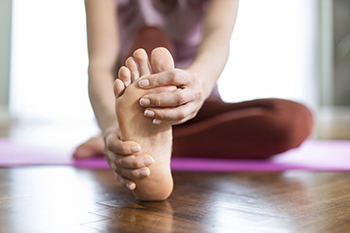
Osteoarthritis, or OA, in the big toe is medically referred to as hallux rigidus. This progressive and degenerative condition is characterized by the breakdown of cartilage at the first metatarsophalangeal, or MTP, joint. As the cartilage in the MTP joint deteriorates, the bones rub together, causing pain, swelling, and stiffness. This discomfort in the big toe often leads to difficulty in bending the toe, and affects mobility and everyday activities, like walking. Furthermore, OA in the big toe can worsen other foot conditions, such as bunions, corns, calluses, and hammertoes. This may further complicate movement and cause additional discomfort. Treatment options for OA in the big toe start with conservative methods, such as pain management and custom orthotic devices. In more severe cases, surgical intervention may be suggested, depending on the severity of the condition and the patient's individual needs. Seeking prompt medical attention from a podiatrist is important for diagnosing and managing hallux rigidus effectively, as early intervention can help to alleviate symptoms, improve mobility, and enhance overall quality of life for individuals affected by this condition. If you believe you may have osteoarthritis that is affecting the big toe, it is suggested that you schedule an appointment with a podiatrist.
Toe pain can disrupt your daily activities. If you have any concerns, contact Dr. Dean D. Hinners of Illinois. Our doctor can provide the care you need to keep you pain-free and on your feet.
What Causes Toe Pain?
Most severe toe pain is caused due to a sports injury, trauma from dropping something heavy on the toe, or bumping into something rigid. Other problems can develop over time for various reasons.
Toe pain can be caused by one or more ailments. The most common include:
- Trauma
- Sports injury
- Wearing shoes that are too tight
- Arthritis
- Gout
- Corns and calluses
- Hammertoe
- Bunions
- Blisters
- Ingrown toenails
- Sprains
- Fractures (broken bones)
- Dislocations
When to See a Podiatrist
- Severe pain
- Persistent pain that lasts more than a week
- Signs of infection
- Continued swelling
- Pain that prevents walking
Diagnosis
In many cases the cause of toe pain is obvious, but in others, a podiatrist may want to use more advanced methods to determine the problem. These can range from simple visual inspections and sensation tests to X-rays and MRI scans. Prior medical history, family medical history, and any recent physical traumatic events will all be taken into consideration for a proper diagnosis.
Treatment
Treatments for toe pain and injuries vary and may include shoe inserts, padding, taping, medicines, injections, and in some cases, surgery. If you believe that you have broken a toe, please see a podiatrist as soon as possible.
If you have any questions please feel free to contact one of our offices located in Metropolis and Eldorado, IL . We offer the newest diagnostic tools and technology to treat your foot and ankle needs.
Causes of Puffy and Swollen Feet
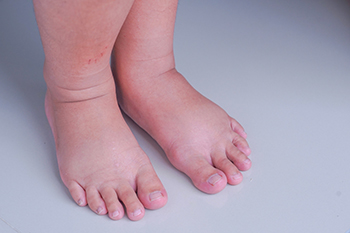
Swollen feet, a common occurrence, can be attributed to various factors that impact the delicate balance of fluid regulation in the body. One primary cause is fluid retention, often linked to prolonged periods of standing or sitting, particularly in hot weather. The force of gravity hinders efficient circulation, leading to fluid pooling in the lower extremities. Additionally, dietary choices high in sodium can contribute to water retention, exacerbating swelling. Injuries or trauma, such as sprains or fractures, may trigger localized swelling as the body's natural response to inflammation. Conditions like venous insufficiency or deep vein thrombosis disrupt blood flow, promoting fluid accumulation. Pregnancy and hormonal fluctuations can also lead to swelling in the feet. If your feet are swollen, it is suggested that you consult a podiatrist who can determine what the cause is, and offer appropriate relief methods.
Swollen feet can be a sign of an underlying condition. If you have any concerns, contact Dr. Dean D. Hinners of Illinois. Our doctor can provide the care you need to keep you pain-free and on your feet.
Swollen feet are a common ailment among pregnant women and people who stand or sit for extended periods. Aging may increase the possibility of swollen feet and patients who are obese often notice when their feet are swelling too. There may be medical reasons why swollen feet occur:
- Phlebitis - A condition that causes the veins to become inflamed and can also cause leg pain.
- Liver disease - This may lead to low blood levels of albumin which is a protein. This can cause fluid in the blood to pass into the tissues and several areas of the body can become swollen.
- Heart failure - When the heart doesn’t pump properly the blood that is normally pumped back to the heart can pool in the veins of the legs causing swollen feet.
- Kidney disease - One of the main functions of the kidneys is releasing excess fluid in the body. This type of condition can make it difficult for the kidneys to function properly, and as a result the feet may become swollen.
- Deep-vein thrombosis (DVT)- This is a serious condition where blood clots form in the veins of the legs. They can block the return of blood from the legs to the heart which may cause the feet to swell. It is important to be treated by a podiatrist if this condition is present.
Swollen feet can also be caused by bone and tendon conditions, including fractures, arthritis, and tendinitis. Additionally, there may be skin and toenail conditions and an infection may cause the feet to swell. Patients who take medicine to treat high blood pressure may be prone to getting swollen feet.
Many patients elevate their feet to help relieve the swelling and this is generally a temporary remedy. When a podiatrist is consulted the reason behind the swelling can be uncovered and subsequently treated.
If you have any questions please feel free to contact one of our offices located in Metropolis and Eldorado, IL . We offer the newest diagnostic tools and technology to treat your foot and ankle needs.
How Common Is Peripheral Artery Disease?
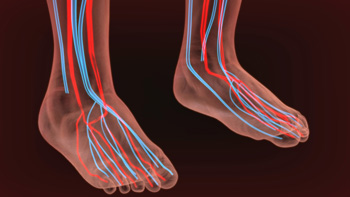 Peripheral artery disease (PAD) is a condition in which the arteries that supply blood to your limbs become narrow and hardened due to a buildup of plaque along the artery walls, leading to poor circulation. This condition is unfortunately quite common, affecting up to 200 million people worldwide. Often, people are not even aware that they have PAD because it does not always produce noticeable symptoms. When symptoms are apparent, they may include pain, cramping, tightness, or fatigue in the lower limbs. These symptoms often become worse with exercise or physical exertion. More advanced PAD can cause pain in the legs even without physical activity, as well as numbness, coldness, and discoloration of the lower limbs. In some cases, wounds that heal poorly may appear on the feet and legs. If you are experiencing any of the symptoms of PAD, or if you are older and at risk of developing this condition, please seek the care of a podiatrist.
Peripheral artery disease (PAD) is a condition in which the arteries that supply blood to your limbs become narrow and hardened due to a buildup of plaque along the artery walls, leading to poor circulation. This condition is unfortunately quite common, affecting up to 200 million people worldwide. Often, people are not even aware that they have PAD because it does not always produce noticeable symptoms. When symptoms are apparent, they may include pain, cramping, tightness, or fatigue in the lower limbs. These symptoms often become worse with exercise or physical exertion. More advanced PAD can cause pain in the legs even without physical activity, as well as numbness, coldness, and discoloration of the lower limbs. In some cases, wounds that heal poorly may appear on the feet and legs. If you are experiencing any of the symptoms of PAD, or if you are older and at risk of developing this condition, please seek the care of a podiatrist.
Peripheral artery disease can pose a serious risk to your health. It can increase the risk of stroke and heart attack. If you have symptoms of peripheral artery disease, consult with Dr. Dean D. Hinners from Illinois. Our doctor will assess your condition and provide you with quality foot and ankle treatment.
Peripheral artery disease (PAD) is when arteries are constricted due to plaque (fatty deposits) build-up. This results in less blood flow to the legs and other extremities. The main cause of PAD is atherosclerosis, in which plaque builds up in the arteries.
Symptoms
Symptoms of PAD include:
- Claudication (leg pain from walking)
- Numbness in legs
- Decrease in growth of leg hair and toenails
- Paleness of the skin
- Erectile dysfunction
- Sores and wounds on legs and feet that won’t heal
- Coldness in one leg
It is important to note that a majority of individuals never show any symptoms of PAD.
Diagnosis
While PAD occurs in the legs and arteries, Podiatrists can diagnose PAD. Podiatrists utilize a test called an ankle-brachial index (ABI). An ABI test compares blood pressure in your arm to you ankle to see if any abnormality occurs. Ultrasound and imaging devices may also be used.
Treatment
Fortunately, lifestyle changes such as maintaining a healthy diet, exercising, managing cholesterol and blood sugar levels, and quitting smoking, can all treat PAD. Medications that prevent clots from occurring can be prescribed. Finally, in some cases, surgery may be recommended.
If you have any questions, please feel free to contact one of our offices located in Metropolis and Eldorado, IL . We offer the newest diagnostic and treatment technologies for all your foot care needs.
How Aging Can Affect Your Feet
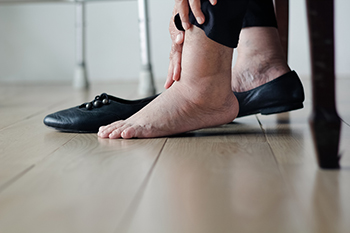
Aging gracefully is a journey that encompasses various changes throughout the body, and the feet are no exception. The intricate network of bones, muscles, and joints in the foot makes it particularly susceptible to the effects of aging. Certain conditions may arise, including plantar fasciitis, flat feet, and osteoarthritis. Plantar fasciitis involves inflammation of the ligament, called the plantar fascia, on the bottom of the foot. This condition often results from participating in high-impact exercises or wearing ill-fitting shoes. The telltale sign is sharp heel pain, especially pronounced in the morning. Flat feet, a consequence of aging and genetic predisposition, can lead to tired feet, painful arches, and swelling on the inner sides. This condition occurs when the supporting tendons and ligaments lose elasticity, a common side effect of aging, and causes the arches to weaken. Osteoarthritis, a prevalent concern for adults over 65, can affect the feet due to the intricate structure of bones and joints. While age increases the risk, repeated ankle sprains may also contribute to arthritis. If you are experiencing any of these foot problems, it is suggested that you schedule an appointment with a podiatrist.
Proper foot care is something many older adults forget to consider. If you have any concerns about your feet and ankles, contact Dr. Dean D. Hinners from Illinois. Our doctor can provide the care you need to keep you pain-free and on your feet.
The Elderly and Their Feet
As we age we start to notice many changes in our body, but the elder population may not notice them right away. Medical conditions may prevent the elderly to take notice of their foot health right away. Poor vision is a lead contributor to not taking action for the elderly.
Common Conditions
- Neuropathy – can reduce feeling in the feet and can hide many life-threatening medical conditions.
- Reduced flexibility – prevents the ability of proper toenail trimming, and foot cleaning. If left untreated, it may lead to further medical issues.
- Foot sores – amongst the older population can be serious before they are discovered. Some of the problematic conditions they may face are:
- Gouging toenails affecting nearby toe
- Shoes that don’t fit properly
- Pressure sores
- Loss of circulation in legs & feet
- Edema & swelling of feet and ankles
Susceptible Infections
Diabetes and poor circulation can cause general loss of sensitivity over the years, turning a simple cut into a serious issue.
If you have any questions please feel free to contact one of our offices located in Metropolis and Eldorado, IL . We offer the newest diagnostic and treatment technologies for all your foot and ankle needs.


